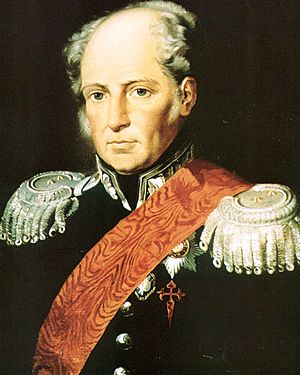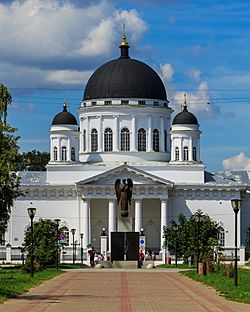Agustín de Betancourt facts for kids
Quick facts for kids
Agustín de Betancourt
|
|
|---|---|

Augustin de Betancourt, 1810s portrait in Russian Major General attire
|
|
| Born |
Agustín José Pedro del Carmen Domingo de Candelaria de Betancourt y Molina
1 February 1758 |
| Died | 14 July 1824 (aged 66) |
| Nationality | Spanish |
| Education | École nationale des ponts et chaussées |
| Occupation | Civil engineer, architect, military engineer, urbanist and inventor |
| Engineering career | |
| Significant design | Moscow Manege, Nizhny Novgorod Fair |
Agustín de Betancourt y Molina (Russian: Августин Августинович де Бетанкур, tr. Avgustin Avgustinovich de Betankur; French: Augustin Bétancourt; 1 February 1758 – 24 July 1824) was a very important Spanish engineer. He worked in Spain, France, and Russia. His projects included everything from steam engines and balloons to designing buildings and planning cities. Betancourt also taught others. He started and led the Spanish Corps of Civil Engineers and the Saint Petersburg Institute of Communications Engineers in Russia. He helped plan and build many things in cities like Saint Petersburg, Kronstadt, and Nizhny Novgorod.
Contents
Early Life and Schooling
Agustín de Betancourt was born in Puerto de la Cruz, Tenerife, Spain. His family had a long history, tracing back to Jean de Béthencourt, who explored the Canary Islands in the 1400s. Agustín's father was a smart businessman who was interested in machines for making textiles (cloth). His sister, Maria del Carmen Betancourt y Molina, was the first woman in Tenerife to publish a scientific paper.
In 1778, Agustín moved to Madrid to study engineering. He never went back to Tenerife. After finishing his studies in 1783, he worked on projects like the Aragon Canal and in mines. In 1784, he went to Paris to learn more about hydraulics (how liquids move) and mechanics (how machines work) at a special engineering school.
Working in Spain and France
Exploring New Technologies
While in France, Betancourt wrote papers about engineering, like on coal mining. But his main job was to find out about new technologies for Spain. He wanted to get modern machines for a special "Cabinet of Machinery" in Madrid. In 1788, he visited England and met James Watt, who was famous for steam engines. Watt didn't want to share his secrets, but Betancourt still learned a lot by watching Watt's engines work.
Back in Paris, Betancourt wrote about steam engines. He designed a steam-powered pump and a mechanical loom (a machine for weaving cloth). He also sent many machines to Madrid. In 1791, he focused on naval technologies, like machines for clearing harbors. He later used his own design for a dredge (a machine to clear mud from water) in Kronstadt. Before the French monarchy fell, Betancourt returned to Madrid with his new discoveries.
In 1792, Betancourt became the Director of the Royal Cabinet of Machinery. He listed hundreds of machines collected from France, England, and the Netherlands. From 1793 to 1795, he continued his work in England. Later, in Paris, he worked with Abraham-Louis Breguet on an optical telegraph (a system for sending messages using signals). Betancourt built his own telegraph in Spain in 1798. In 1783, he also helped launch Spain's first hot-air balloon.
Leading Engineering Projects
In 1797, Betancourt was given important jobs because of his achievements. He became the Chief Inspector of Ports and Communications in Spain. He also became the Chief of the Corps of Engineers for the Spanish military. In 1802, he started Spain's first civil engineering college, the School of the Corps of Engineers. He led this school until 1807.
Betancourt also helped write a very important textbook called Essai sur la composition des machines (Essay on the Composition of Machines). This book, published in 1808, taught students how to design machines. It became widely used in universities across Europe and was translated into English and German.
In 1807, Betancourt moved to Paris and joined the French Academy of Sciences. Soon after, he was asked to work for Russia. He left France for Saint Petersburg in 1808.
Working in Russia
Betancourt joined the Russian service as a Major General. He was part of the Directorate of Communications. One of his first projects was a famous fountain in Tsarskoye Selo (1810). In 1816, Betancourt became the head of the Commission for Construction and Hydraulics. This group focused on developing Saint Petersburg. From 1819, he also led the Directorate of Communications. He helped train many famous architects, like Auguste de Montferrand.
Building Bridges and Structures
From 1811 to 1813, Betancourt built Saint Petersburg's first bridge across the Malaya Nevka river. This wooden bridge, named after Betancourt, lasted for 50 years. It was the only wooden bridge to survive a big flood in 1824. He designed similar bridges for other cities like Warsaw and Tula.
In 1816, Alexander I of Russia asked Betancourt to find an architect to rebuild Saint Isaac's Cathedral. Betancourt suggested Montferrand. Betancourt designed the cathedral's strong dome using three connected steel domes. This design was very modern for its time. The dome was built in 1841.
In Moscow, Betancourt oversaw the building of the Moscow Manege (1817). This large building, 166 meters long, needed a roof without any inside columns. Betancourt designed the wooden roof trusses (support beams) himself. The whole project was finished in just six months.
Planning Cities
In 1816, a fire destroyed the Makaryev Fair. The fairgrounds were moved to Nizhny Novgorod. Betancourt visited the site in 1817 and suggested a large project to rebuild the fair in stone. He managed the overall planning and money. Montferrand designed the individual buildings. Betancourt traveled to Nizhny Novgorod every year to check on the building work. The Saviour Cathedral, also known as Old Fair Cathedral, was designed by Betancourt and Montferrand. It was finished in 1822, when the fair opened. The fair continued until 1930.
Betancourt also designed other buildings for Nizhny Novgorod, like the city jail. He helped save two old churches. His master plan guided the city's development for many years.
Russia's first steamship, the Yelizaveta, was designed by Charles Baird and Betancourt in 1815.
In 1810, Betancourt finished his steam-powered dredge. This machine was used to make the waters around Kronstadt deeper. It also helped build a canal.
After the French invasion of Russia (1812), Russia's money system was in trouble. Dmitry Guriev, the Minister of Finance, asked Betancourt to create a modern currency printing factory. By 1816, Betancourt designed the buildings, machines, and the entire process. The new printshop (now called Saint Petersburg Goznak) opened in 1818.
Betancourt also designed Russia's first modern highway between Saint Petersburg and Moscow. He worked on many industrial projects, like the Tula and Kazan armouries (places where weapons are made).
In 1809, Betancourt started the Saint Petersburg Institute of Communications Engineers. This was Russia's first engineering college. He led the Institute until 1824.
Later Years
In 1822, Betancourt lost some favor at the court and was no longer the Director of Communications. However, he kept other important state jobs. In 1823, his only daughter died, and he was very sad. He resigned in February 1824 and passed away on July 14, 1824, in Saint Petersburg, Russia.
He was buried in the Smolensk Lutheran cemetery in Saint Petersburg. His tomb, a tall cast-iron column, was designed by Auguste de Montferrand. In 1979, his grave was moved to the Lazarevskoe Cemetery.
Today, Saint Petersburg has three monuments to Betancourt. The "Betancourt's Medal" is an award given each year by Russian Railways for great work in science and education.
See also
 In Spanish: Agustín de Betancourt para niños
In Spanish: Agustín de Betancourt para niños



